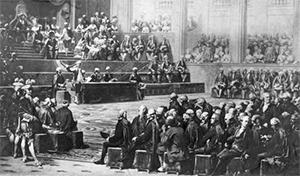The Estates-General
Part 2: The Final Meeting The only Estates-General that convened after 1614 was the last ever meeting. King Louis XVI, in the throes of a dispute with not only the parlement, but also much of the nobility, summoned the Estates-General in order to (he hoped) approve approve a set of monetary reforms that had otherwise been rejected. The king, in an effort to keep the clergy and nobility in the fold, agreed that the meetings would take place under traditional arrangements. Such arrangements clearly favored members of the First Estate (clergy) and the Second Estate (nobility) but disadvantaged the members of the Third Estate (peasants). Notably and symbolically, the clergy and nobility got to wear their finest clothes while marching into the assembly, whereas the peasants were required to wear plain black clothes.
Tensions between rich and poor that had been bubbling up for years boiled over at this and other real or perceived slights, and the Third Estate members of the Estates-General demanded double representation. This was significant because the membership in the assembly was not done according to population. The members of the First and Second Estates combined was about 50,000; the Third Estate numbered 25 million. In the 1789 Estates-General, 296 deputies represented the First Estate, 282 represented the Second Estate, and 610 represented the Third Estate. And yet, representation in the Estates-General was equal for each Estate when it came to voting on something, which was the way in which Estates-General worked. So in fact, if the First Estate and Second Estate agreed on something (which they usually did), then they could force its approval, even if the Third Estate did not agree. The government did not grant double representation for the Third Estate. In response, the Third Estate on June 17, 1789 declared itself the National Assembly. The king responded by shutting the doors of the place where the National Assembly had been meeting, and the members of the assembly adjourned to a nearby tennis court, on which they sword the Tennis Court Oath, which bound them to one another and to the common cause of securing for their country a constitution. By this time, a large number of clergy and nobility had found enough in the Third Estate's actions to sign on. On July 9, the National Assembly became the National Constituent Assembly, which officially did away with the Estates-General. First page > Origins and Controversies > Page 1, 2 |
|
Social Studies for Kids
copyright 2002–2025
David White





